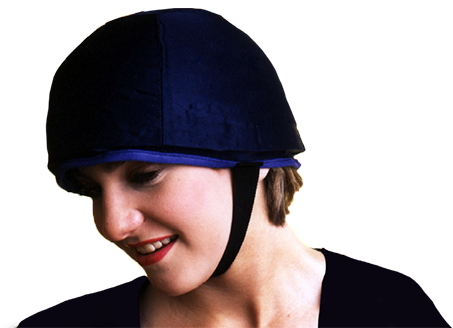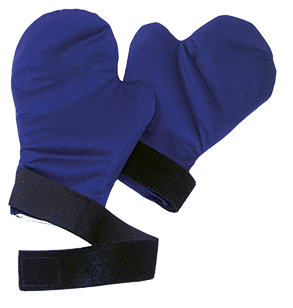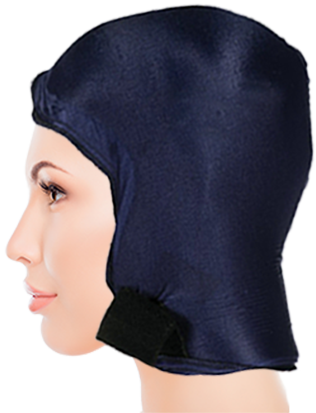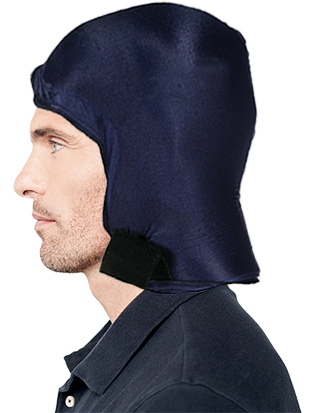CLINICAL STUDIES
THE CLINICALLY PROVEN EFFICACY OF THE COLD CAP

Effectiveness of the Cold Cap in the Prevention of Docetaxel-Induced Alopecia
M. Lemenager,¹ S. Lecomte,¹ M.E. Bonneterre,¹ E. Bessa, ² J. Dauba ¹ and J. Bonneterre¹
¹ Centre Oscar Lambret, BP 307, F.59020 Lille Cedex; and ²Laboratoire Bellon, Neuilly, France
Docetaxel is a new taxoid antineoplastic agent with clinical efficacy especially in breast cancer. One of the most distressing side-effects induced by docetaxel is alopecia. We studied the prevention of alopecia by using a cold cap in 98 patients receiving 100 mg/m² docetaxel by 1 h i.v. infusion every 3 weeks. One patient was lost to follow-up. 83 patients (86%) were evaluated as a success to the cold cap, as they presented WHO grade alopecia ≤ 2 and no need to wear a wig. 14 patients (14%) had to wear a wig; among them, 7 patients withdrew before the evaluation at three cycles. The cold cap is a very effective technique with minimal side-effects for docetaxel-treated patients. © 1997 Elsevier Science Ltd. All rights reserved.
Key words: alopecia, chemotherapy, toxicity
Eur ‘J Cancer, Vol. 33, No. 2, pp. 297-300, 1997
Introduction
DOCETAXEL (TAXOTERE) is a new antineoplastic agent from the taxoid family, which promotes the assembly of microtubules, stabilizing them and preventing their depolymerisation. Several phase II trials have demonstrated that this drug has significant and consistent anti-tumor activity in metastatic breast and non-small-cell lung cancers. It has also produced significant results in other tumors among which include ovarian cancer [1, 2]. Currently, the recommended dose of docetaxel for phase II or III studies is 100 mg/m² administered as a 1-h i.v. infusion repeated every 21 days. Phase I trials have demonstrated the toxicity of docetaxel: dose-limiting neutropenia, paresthesias, asthenia, oral mucositis, fluid retention, nail changes and alopecia [1]. Alopecia is common at doses higher than 55 mg/m², and has been observed in over two-thirds of patients at doses higher than 70 mg/m² during phase I trials [1]. Alopecia occurs in over 80% of patients receiving docetaxel at the dose of 100 mg/m² [3] and represents a major psychological drawback for the patients, especially for women. Although mostly transient, alopecia is one of the most distressing side-effects of anticancer chemotherapy. In a study on patient perception of the side-effects of chemotherapy, patients chose alopecia as the second worst physical side-effect after nausea and vomiting [4]. Another study showed that 88% of the women who received pre-operative chemotherapy for breast cancer considered alopecia the most burdensome aspect of the treatment [5]. Hair loss can induce a negative body image, alter interpersonal relationships, reduce the quality of life and generated enough anxiety to cause some patients to reject potentially curative treatments, particularly women.
In our day-care hospital, the prevention of alopecia is an important endpoint for nurses and physicians. We use the cold cap for the prevention of anthracyclin-induced alopecia: 85% of female patients have no, minor or moderate alopecia and they do not need to wear a wig or a hat [6]. Due to differences in chemotherapy administration schedules (10-min bolus for epirubicin versus 1 h for docetaxel), the research nurses modified the cold cap technique and adapted it to docetaxel chemotherapy [1]. Preliminary results showed good protection from hair loss in 39 patients receiving docetaxel 100 mg/m² for metastatic breast cancer as second- or third-line chemotherapy. 21 patients had no alopecia, grade 1 was observed in 15 patients, grade 2 in two patients, and one patient had grade 3 alopecia, who had to wear a wig [7].
The following study reports the full data which confirm these promising results and promotes the cold cap safety and efficacy for the prevention of docetaxel-induced alopecia.
Patients and Methods
All patients were treated as out-patients. 98 patients received docetaxel alone (100 mg/m² i.v., every 21 days) after failure of one or more previous chemotherapy regimen during a compassionate use program or ongoing clinical trials from April 1992 to October 1995.
Patients were offered a cold cap technique aimed at the prevention of docetaxel-induced alopecia and were informed by the oncologists. The patients (93 females and 5 males) received docetaxel chemotherapy for metastatic breast cancer (n=88), advanced ovarian cancer (n=3) and advanced pancreatic cancer (n=7). Previous chemotherapy regimens were either epirubicin-based or contained mitoxantrone, vinorelbine, cisplatin, cyclophosphamide or 5-fluorouracil. Some patients had previously worn a cold cap or had already experienced hair loss during their cancer treatment.
Patients were ineligible if they had scalp metastases, prior radiation to the scalp, presence of baldness or significant hair loss. Clinical and biochemical signs of liver metastases or impairment of the liver function were recorded at admission. Patients with transaminase enzyme levels below 2.5 times the upper normal limit were eligible to receive docetaxel chemotherapy. Patients with significant liver metastases were eligible for docetaxel chemotherapy and cold cap if they had only a minor impairment of their liver function.
The cold cap was placed in the freezer for a minimum of 12 h prior to use. The temperature of the cap had to be below -25°C. First, a wet single-use mobcap was placed on the patients’ hair. To apply the cap as tightly as possible, it was kept in place by bandages wrapped around the head. Cotton protected the nape, forehead and ears. The cold cap was applied 15 min. before the administration of docetaxel and left in place for 30 min. after the beginning of the infusion; then the second cap was worn for 45 min. Two cold caps were successively used (45 min. for each); the cap changing was done quickly by two nurses. To improve the hair protection, the research nurses gave some advice to the patients: no hair brushing during the treatment day, no shampoo for one week, no permanent wave or hair coloring during chemotherapy treatment, and to have a short haircut. This was done every time the patient received docetaxel. The patients were followed and treated until they either stopped receiving docetaxel, or had total hair loss.
Measurement of the degree of hair loss was determined by the nurse. Alopecia was assessed before each docetaxel cycle and during at least three consecutive cycles. Hair loss was evaluated using the World Health Organization (WHO) criteria for alopecia (grade 0, no hair loss; grade 1, minimal hair loss; grade 2, moderate hair loss, patchy alopecia; grade 3, complete but reversible hair loss; grade 4, complete and irreversible alopecia).
Success was defined as WHO alopecia grade ≤ 2 and no need to wear a wig, according to patient’s decision. If the patient wore a wig whatever the grade of alopecia, this was considered a failure.
Results
98 patients received docetaxel chemotherapy in combination with the cold cap. All patients but one were able to be evaluated for the results; one patient was not able to be evaluated, as she refused to continue chemotherapy and was lost to follow-up. The median age was 49 years (range 29-73). The median number of previous chemotherapy regimens was 2 (range 0-5). 83 female patients had previously received epirubicin-based regimen as adjuvant or metastatic treatment. All patients except one received at least 3 docetaxel chemotherapy cycles, the median number was 5 cycles (range 2-11).
The results are shown in Table 1. 14 (14%) patients were evaluated as a failure to the cold cap: 7 of them refused to go on through the three cycles with the caps (one at cycle 1, two at cycle 2 and 4 at cycle 3); the other 7 patients had to wear a wig, 3 had presented with grade 2 alopecia and 4 patients had grade 3 alopecia. 83 (86%) patients were successful responders to the cap as they had both grade ≤ 2 alopecia and did not need to wear a wig.
When considering prior treatment, 83 out of the 97 patients able to be evaluated had previously received anthracyclin-based chemotherapy (mostly epirubicin). Information on the results of alopecia prevention (with a cold cap) at the time of anthracyclin chemotherapy was available for 50 of these patients: 20 grade 0, 20 grade 1, 9 grade 2, 1 grade 3, and no grade 4. These same patients had the following results for docetaxel-induced alopecia prevention: 25 grade 0, 15 grade 1, 6 grade 2, 4 grade 3 and no grade 4. 14 patients had not previously received an anthracyclin-based regimen, and their results of docetaxel-induced alopecia prevention were 3 grade 0, 5 grade 1, 4 grade 2, and 2 grade 3.
The cold cap was well tolerated. Its side-effects were mild headaches and unpleasant cold sensations. Only 7 patients refused to go on with the cold cap (ad were considered as failures): 5 complained of headaches and 2 were not satisfied because of hair thinning. None of the patients treated with scalp hypothermia developed scalp metastases, with a median follow-up after the end of the treatment of 9 months (range 4-12).
Discussion
Despite the fact that alopecia is one of the most common side-effects of chemotherapy, especially with anthracyclins and taxoids, with a major social and psychological impact, relatively few trials evaluating different prevention approaches have been reported. A literature review has recently been published [8]. Four studies showed failure of hair loss prevention, but most series showed good hair preservation in 50-80% of patients with a scalp-cooling method. Several techniques were used to induce hypothermia: simple bags with crushed ice or frozen cryogel packs, caps containing cryogel and an insulation layer, caps connected to a cooling device using air or fluid and equipped with a thermostat [8].
The rationale for the use of cold caps is that scalp hypothermia causes cutaneous vasoconstriction with a reduced blood flow, leading to a reduction in the quantity of drugs reaching the hair follicles [9]. The pharmacokinetics of docetaxel fit a tri-exponential curve; the α, β, and γ half-lives with a 115 mg/m² 1-h infusion are 4 min., 36 min., and 22 h, respectively [1]. This means that the drug is present at high concentrations in the capillary circulation for a duration which is shorter than that of hypothermia. Cellular uptake by the hair follicles may also be reduced because of the lower temperature [10]. finally, a reduction in the metabolism of local tissue, in response to low temperature rather than reduced blood flow, is the most significant factor in preventing alopecia [8, 11].
Limited data are available on the degree of the cooling temperature that must be obtained. Hair conservation could be obtained when scalp temperature is reduced to a level ≤ 24°C [12] or < 22°C [10]. In our experience, assessment of scalp hypothermia was not done. Clinical experiences have revealed that hair preservation is improved when the temperature of the cap is around -25°C after remaining at least 12 h in the freezer. The cold caps are always placed in the freezer on the evening prior to use. A cap is used only once per day.
The precooling time ranges from 5 to 20 min. (15 min. in our study) [8]. Most of the reviewed series use a post-injection cooling time of 30 min. (range 15-60) probably taking the doxorubicin pharmacokinetics as their guidelines [8]. The post-injection cooling time with docetaxel (1-h infusion) was 15 min. in our study.
Various chemotherapy drugs have been used, with several dosages, to evaluate the efficacy of the cold cap. The degree of protection against alopecia is both drug and dose-dependent. Scalp hypothermia resulted in 100% (5/5) minor or no hair loss when a dose of < 50 mg. [11]. Our experience shows the same difference between the FEC 50 regimen (epirubicin 50 mg/m², 5-fluorouracil 500 mg/m², cyclophosphamide 500 mg/m²) and the FEC 100 regimen (epirubicin 100 mg/m²) in larger studies. Hair preservation (alopecia grade ≤ 2 and no wig) was 85% (64/73) with the cold cap during FEC 50 chemotherapy and fell to 64% (25/39) with FEC 100 chemotherapy and increased epirubicin doses (J. Bonneterre, Centre Oscar Lambret, France). No evident difference seems to exist between the results obtained in the prevention of epirubicin-induced alopecia and docetaxel-induced alopecia: 85% hair preservation was achieved in both series. In addition, previous epirubicin treatments do not seem to decrease the efficacy of the cold cap in the prevention of docetaxel-induced alopecia.
Most physicians recommend that the cold cap should not be used in haematological malignancies or solid tumors which could spread to the scalp. One study reported scalp recurrence in a patient with mycosis fungoides who was treated with a cold cap [13]. In two series [14, 15], 5 cases of scalp metastases after cold cap use in a series of 96 patients, treated for metastatic breast cancer, were also reported. No report of scalp metastasis after the cold cap in adjuvant breast cancer chemotherapy was found in the literature [8]. In another study, no scalp metastasis was observed [11]. In our experience, we have been using the cold cap for about 15 years and no increase in the rate of scalp metastases has been observed.
The influence of liver metastases in decreasing the effectiveness of the cold cap has been raised by several authors [16, 17]; impaired liver function could reduce the excretion of the drug. There is no evidence that liver function decreased the efficacy of the cold cap. In one study [15], all patients receiving adjuvant chemotherapy had normal liver function and failed to benefit from cold caps. Conversely, despite a high rate of liver metastasis in our patients, we obtained very good hair preservation.
The cold cap is well tolerated. The side-effects are headaches, unpleasant cold sensation and occasional complaints of a ‘heavy’ cap [11,17]. Tolerability is very good and comparable to other studies [11-17]. Few patients refused the cold cap without having tried it, mostly because they were more anxious and fearful of losing their hair than of the temporary discomfort of the cold cap. However, 10 patients refused the cold cap during the docetaxel regimen; putting the cold cap on and changing it is a very time-consuming process for the nursing staff. In our experience, there is no necessity to measure the scalp temperature during treatment.
Other techniques to prevent chemotherapy-induced alopecia are being studied with limited success to date. A phase I trial of intracutaneous interleukin 1 to prevent cytarabine-induced alopecia showed no significant protection [18]. Minoxidil is known to induce hair growth in men with male pattern baldness. A minoxidil topical solution was not effective in the prevention of doxorubicin-induced alopecia in a placebo-controlled study [19].
Alopecia is one of the most distressing side-effects of chemotherapy. docetaxel, a taxoid with a broad range of anti-tumor activity, often induces complete and reversible alopecia. The simple technique of scalp cooling appears to be as useful in preventing alopecia induced by docetaxel as it is for epirubicin. The cold cap is safe, well accepted by patients and with no major side-effects. The cold cap can be recommended for routine use in docetaxel chemotherapy, to improve the quality of life of cancer patients.
References
Cortes JE, Pazdur R. Docetaxel. F Clin Oncol 1995, 13, 2643-2655.
Gelmon K. Th taxoids: paclitaxel and docetaxel. Lancet 1994, 344, 1267-1272.
Chevalier B, Fumoleau P, Kerbrat P, et al. Docetaxel is a major cytotoxic drug for the treatment of advanced breast cancer: a phase II trial of the clinical screening cooperative group of the European Organization for Research and Treatment of Cancer. J Clin Oncol 1995, 13, 314-322.
Coates A, Abraham S, Kaye SB, et al. On the receiving end – patient perception of the side-effects of cancer chemotherapy, Eur F Cancer Clin Oncol 1983, 19, 203-208.
Kiebert GM, Haes JCJM de, Kievit J, et al. Effect of perioperative chemotherapy on the quality of life of patients with early breast cancer. Eur J Cancer 1990, 26, 1038-1042.
Bonneterre J, Wartel C, Bachelet H, et al. Efficacy of scalp hypothermia in patients receiving anthracycline chemotherapy. 1st International Symposium on Supportive Care in Cancer Patients. St Gallen, Switzerland, February 1987, 18-21.
Lemenager M, Genouville C, Bessa EH, et al. Docetaxel-induced alopecia can be prevented. Lancet 1995, 346, 371-372.
Tollenaar R, Liefers GJ, Repelaer van Driel OJ, et al. Eur J Cancer 1994, 30A, 1448-1453.
Bulow J, Friberg L, Gaardsting O, Hansen M. Frontal subcutaneous blood flow, and epi- and subcutaneous temperatures during scalp cooling in normal man. Scand F Clin Lab Invest 1985, 45, 505-508.
Gregory RP, Cooke T, Middleton J, et al. Prevention of doxorubicin-induced alopecia by scalp hypothermia: relation to degree of cooling. Br Med F 1982, 284, 1674.
Satterwhite B, Zimm S. The use of scalp hypothermia in the prevention of doxorubicin-induced hair loss. Cancer 1984, 54, 34-37.
Cooke T, Gregory RP, Middleton J, et al. Prevention of doxorubicin-induced alopecia. Br Med F 1981, 282, 734-735.
Witman G, Cadman Ed, Chen M. Misuse of scalp hypothermia. Cancer Treat Rep 1981, 65, 507-508.
Vendelbo Johansen L. Scalp hypothermia in the prevention of chemotherapy-induced alopecia. Acta Radiol 1985, 24, 113-116.
Middleton J, Franks D, Buchanan RB, et al. Failure of scalp hypothermia to prevent hair loss when cyclophosphamide is added to doxorubicin and vincristine. Cancer Treat Rep 1985, 69, 373-375.
Anderson JE, Hunt JM, Smith IE. Prevention of doxorubicin-induced alopecia by scalp cooling in patients with advanced breast cancer. Br Med F 1981, 282, 423-424.
Wheelock JB, Myers MB, Krebs HB, et al. Ineffectiveness of scalp hypothermia in the prevention of alopecia in patients treated with doxorubicin and cisplatin combinations. Cancer Treat Rep 1984, 68, 1387-1388.
Daghistani D, Jimenez JJ, Maharaj D, et al. A phase I trial of intracutaneous interleukin-1 (IL-1) for the prevention of chemotherapy-induced alopecia. Proc Am Soc Clin Oncol 1994, 13, A1545.
Rodriguez R, Machiavelli M, Leone B, et al. Minoxidil (Mx) as a prophylaxis of doxorubicin-induced alopecia. Ann Oncol 1994, 5, 769-770.
Acknowledgments – The authors express their gratitude to the Oncology Research Nursing Staff of the Department: Danièle Bauwens, Delphine Boidin, Laurence Dewiite, Christine Janicki, Nathalie Marechal, Anne-Bérangè Noirot, Frédérique Renart and Florence Trache.




